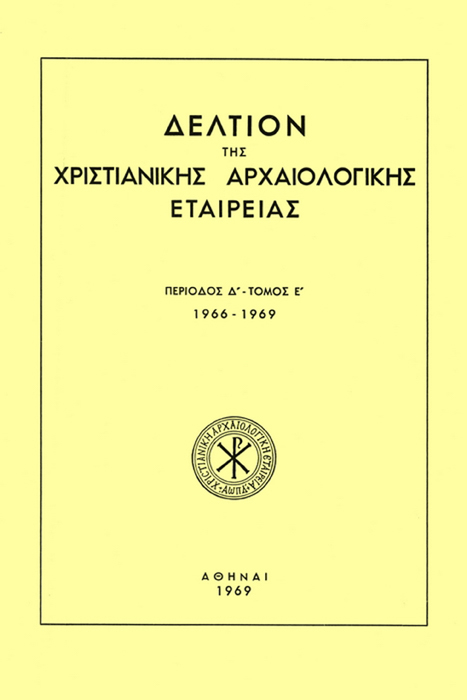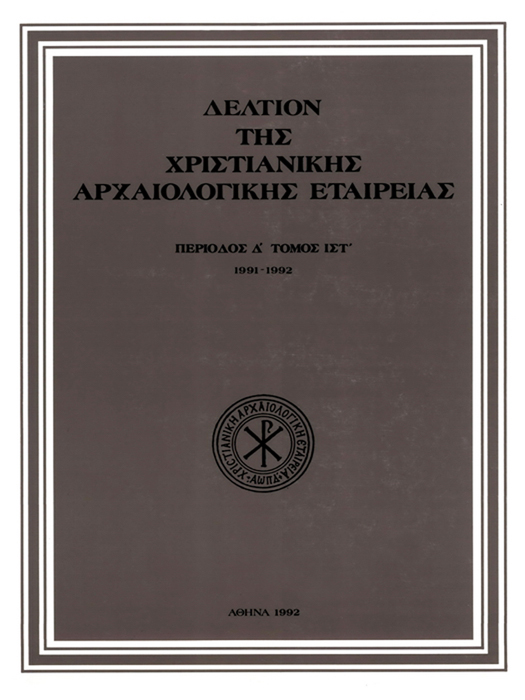Wall-paintings in St. Catherine's Monastery of Sinai (pl. 71-84)
Abstract
Two wall paintings have been discovered in recent years in the Monastery by the Greek Mission of the Archaeological Service, which has worked in Sinai on the restoration of the Icons (1962-1967). In 1962, a complete composition was revealed by the Greek restorers under a dark thick varnish in the Sanctuary of St. James' chapel in the main church, and in 1967 a painted niche was discovered in a kind of a small chapel formed in a hollow on the south side of the north outer wall of the Monastery at a height of three meters. These well preserved fresco paintings — rare in the Sinaitic Monastery—provide evidence that a Sinaitic workshop existed and worked at this place at a precise period of time. After a specific investigation in Sinai and in the Photographical Archives of the Sinai material in Athens and in Princeton (note 2) it has been possible to attribute a number of more than a hundred Icons of the Monastery to the same workshop. a) St. James' Chapel (pi. 71 - 75). The scene represents the Virgin as the Burning Bush in the midst of St. Basil and John Chrysostom, St. James and Moses. All f've figures are standing in frontal positions. Above them an imposing bust of Christ stands out of the semicircular sky and awards a precious book to St. James and the Tablets of the Law to Moses (pi. 71 -75). This well ordered compositional scheme derives from earlier apsis decorations (Bawît, San Venanzio in Rome — 7th century — note 5), but its specific iconographical features are purely Sinaitic : the depiction of the Virgin in the Burning Bush, which appears here as an isolated fully developed iconical type, not encountered before the 13th century (notes 6-7, 12-16), Moses with the Tablets of the Law received on Mount Sinai, the two fathers of the Church, to whom a chapel was dedicated in the area of the Monastery (notes 17- 18). The well balanced distribution of the awards of Christ to one personage of the New and another of the Old Testament, as well as the anachronism in the immediate connection of Christ and Moses are to be noticed. Both features are rare but not unknown in the iconography of that time. In general, the attitude of the immobile, frontally standing figures give a strong monumental character to the whole composition, a feature which is typical of the Middle Byzantine painting, particularly in the early 13th century. It is clear that the Sinaitic painter, working on themes and motives of the usual Orthodox language, has followed a local iconographical tradition, specimens of which exist in the numerous portable Sinaitic icons (notes 8-11). b) The Wall Chapel (pi. 76 - 80). The whole painting which covers the niche has the measurements of a portable icon (63 X 65 cm), and represents a bust of the Virgin in the Odigitria type which covers the flat back wall of the niche, surrounded by nine medallions each containing a bust of two archangels, the prophets Moses, Elijah, Aaron and Elisha and Sts. John of the Climax and Catherine. The top medallion contains an X (= Χριστός). It is clear that the selection of the figures accompanying the Virgin is purely Sinaitic (note 19). The technical and stylistic features of both wall paintings are closely interconnected, so that these could easily be attributed to the same local workshop. The manner of rendering the strong plasticity of the figures with light green shadows and large warm ochre cheeks, the lighting with soft white strokes diffused on the surface (in painterly manner), the loose treatement of the wide and in a way inelegant but rythmically formed draperies, are common features to both mural scenes, as well as in a number of portable icons. The origin of these characteristics is not difficult to localise in the paintings of the Palaeologan era. To these can be added the golden nimbus and a kind of sphericity of heads (pi. 75,1), which can find parallels in paintings of the first half of the 15th century (Gregory Palamas wall painting) in Agios-Demetrius in Salonica, wall paintings in Resava (note 33 - 34). We can also add the hanging veils painted on either side of the Virgin in the Wall Chapel (pi. 76, notes 20 and 26). On the other hand, the figure in itself of the Virgin is related to icons of the Macedonian region of the first half of the 15th century (notes 23-25). However the important point is the discovery of the precise prototypes of our figures amongst the vast Sinai collection of icons. This point of view can be supported by more than one example, but the large unpublished Icon of Sts. Peter and Paul on either side of St. Andrew can serve as capital evidence : the middle figure of Andrew is painted over, covering the original figure of St. Theodosius the Coenobiarch (pi. 81). The original icon can be dated to the 12th century, but the new figure of Andrew is closely related to our group (pi. 74, 1 and 82). It is clear however that the intention was to imitate as far as possible the figures of Peter and Paul. To the same group we can attribute, among other, a series of eight unpublished panels representing the apostles Mark and James, the Brother of God (pi. 83,1 - 2) and six Bishops, all standing in the position of celebrating the mass. One can suppose, on reasonable grounds, that this set was originally made in order to decorate the iconostasis of St. James'Chapel, at the same date and by the same painters who decorated the apsis. The stylistic analysis of the draperies proves that the immediate prototypes for these paintings can be some icons of the 11th and 12th centuries existing in the Monastery (notes 30-31), chosen in an eclectic manner and executed with the typical features of our group. On the other hand, from the point of view of portraiting, only a restricted number of types is used, the same in both wall paintings and icons. These placid faces are distinguished by a lack of vitality, of nobility and of spirituality. This and other features clearly distinguish the work attributed here to the Sinaitic workshop from the presumed prototypes. There is a clear difference between these wall paintings and icons and the pure Palaeologan or older pieces in which exist some connections mentioned above (note 33). This is important from the chronological point of view. Some comparisons with works of the second half of the 15'h century, as the wall paintings in the Pedoula Monastery (1474) or in Galata (1514), both in Cyprus (note 36), as well as with some wall paintings in Castoria (note 37), will convince us that the Sinaitic workshop was active (in a general way) during the second half of the 15th century. However, it is difficult to be more precise in the actual progression of our research as to the location of the proveniance of this workshop, as well as to the probable evolution of its style and technique. In summarising the importance and the character of the now defined Sinaitic workshop of the late 15th century, it may be said that the acquaintance of two so far unknown wall paintings and the consecutive definition of a local workshop, add a new important chapter to the art history of this ancient sacred place. The historical evidence is favourable to this point of view, while this precise period of the decline of Byzantine Hellenism and Orthodoxy is proved to be a time of economical prosperity of this Greek community lost in the Sinaitic desert, due to its immense prestige in the eyes of Christianity of the West (note 38). From another point of view the projected publication of the whole material concerning this matter (note 3) will be an important contribution to the study of the problems of post- Byzantine painting, during the first period after the fall of Constantinople.
Article Details
- How to Cite
-
ΧΑΤΖΗΔΑΚΗΣ Μ. (1972). Wall-paintings in St. Catherine’s Monastery of Sinai (pl. 71-84). Deltion of the Christian Archaeological Society, 6, 205–232. https://doi.org/10.12681/dchae.816
- Section
- Articles
The copyright for articles in the journal Deltion of the Christian Archaeological Society (henceforth Deltion) is retained by the author(s), with first publication rights granted to the journal and to EIE/ EKT the right to store and communicate these articles to the public via its information infrastructures. By virtue of their appearance in this journal, articles are free to use with proper attribution for non-commercial uses under a ShareAlike obligation. The Christian Archaeological Society and EIE/EKT retain the worldwide right to reproduce, display, distribute, and use articles published in the Deltion in all formats and media, either separately or as part of collective works for the full term of copyright. This includes but is not limited to the right to publish articles in an issue of the Journal, copy and distribute individual reprints of the articles, authorize reproduction of articles in their entirety in another publication of the Christian Archaeological Society, and authorize reproduction and distribution of articles or abstracts thereof by means of computerized retrieval systems.











